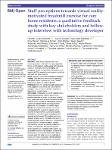Staff perceptions towards virtual reality-motivated treadmill exercise for care home residents: a qualitative feedback study with key stakeholders and follow-up interview with technology developer
| dc.contributor.author | Bradwell, HL | |
| dc.contributor.author | Cooper, L | |
| dc.contributor.author | Edwards, KJ | |
| dc.contributor.author | Baxter, R | |
| dc.contributor.author | Tomaz, SA | |
| dc.contributor.author | Ritchie, J | |
| dc.contributor.author | Gaudl, S | |
| dc.contributor.author | Veliz-Reyes, A | |
| dc.contributor.author | Ryde, GC | |
| dc.contributor.author | Križaj, T | |
| dc.contributor.author | Warren, A | |
| dc.contributor.author | Chatterjee, A | |
| dc.contributor.author | Willis, K | |
| dc.contributor.author | Haynes, R | |
| dc.contributor.author | Hennessy, CH | |
| dc.contributor.author | Whittaker, AC | |
| dc.contributor.author | Asthana, S | |
| dc.contributor.author | Jones, RB | |
| dc.date.accessioned | 2023-11-29T16:42:32Z | |
| dc.date.available | 2023-11-29T16:42:32Z | |
| dc.date.issued | 2023-11-23 | |
| dc.identifier.issn | 2044-6055 | |
| dc.identifier.issn | 2044-6055 | |
| dc.identifier.other | e073307 | |
| dc.identifier.uri | https://pearl.plymouth.ac.uk/handle/10026.1/21758 | |
| dc.description.abstract |
Objectives Health and care resources are under increasing pressure, partly due to the ageing population. Physical activity supports healthy ageing, but motivating exercise is challenging. We aimed to explore staff perceptions towards a virtual reality (VR) omnidirectional treadmill (MOTUS), aimed at increasing physical activity for older adult care home residents. Design Interactive workshops and qualitative evaluation. Settings Eight interactive workshops were held at six care homes and two university sites across Cornwall, England, from September to November 2021. Participants Forty-four staff participated, including care home, supported living, clinical care and compliance managers, carers, activity coordinators, occupational therapists and physiotherapists. Interventions Participants tried the VR treadmill system, followed by focus groups exploring device design, potential usefulness or barriers for care home residents. Focus groups were audio-recorded, transcribed verbatim and thematically analysed. We subsequently conducted a follow-up interview with the technology developer (September 2022) to explore the feedback impact. Results The analysis produced seven key themes: anticipated benefits, acceptability, concerns of use, concerns of negative effects, suitability/unsuitability, improvements and current design. Participants were generally positive towards VR to motivate care home residents’ physical activity and noted several potential benefits (increased exercise, stimulation, social interaction and rehabilitation). Despite the reported potential, staff had safety concerns for frail older residents due to their standing position. Participants suggested design improvements to enhance safety, usability and accessibility. Feedback to the designers resulted in the development of a new seated VR treadmill to address concerns about falls while maintaining motivation to exercise. The follow-up developer interview identified significant value in academia–industry collaboration. Conclusion The use of VR-motivated exercise holds the potential to increase exercise, encourage reminiscence and promote meaningful activity for care home residents. Staff concerns resulted in a redesigned seated treadmill for those too frail to use the standing version. This novel study demonstrates the importance of stakeholder feedback in product design. | |
| dc.format.extent | e073307-e073307 | |
| dc.format.medium | Electronic | |
| dc.language | en | |
| dc.publisher | BMJ | |
| dc.subject | virtual reality | |
| dc.subject | physical therapy modalities | |
| dc.subject | information technology | |
| dc.title | Staff perceptions towards virtual reality-motivated treadmill exercise for care home residents: a qualitative feedback study with key stakeholders and follow-up interview with technology developer | |
| dc.type | journal-article | |
| dc.type | Article | |
| plymouth.author-url | https://www.ncbi.nlm.nih.gov/pubmed/37996232 | |
| plymouth.issue | 11 | |
| plymouth.volume | 13 | |
| plymouth.publisher-url | http://dx.doi.org/10.1136/bmjopen-2023-073307 | |
| plymouth.publication-status | Published | |
| plymouth.journal | BMJ Open | |
| dc.identifier.doi | 10.1136/bmjopen-2023-073307 | |
| plymouth.organisational-group | |Plymouth | |
| plymouth.organisational-group | |Plymouth|Research Groups | |
| plymouth.organisational-group | |Plymouth|Faculty of Arts, Humanities and Business | |
| plymouth.organisational-group | |Plymouth|Faculty of Health | |
| plymouth.organisational-group | |Plymouth|Faculty of Health|School of Nursing and Midwifery | |
| plymouth.organisational-group | |Plymouth|Research Groups|Institute of Health and Community | |
| plymouth.organisational-group | |Plymouth|Faculty of Arts, Humanities and Business|School of Art, Design and Architecture | |
| plymouth.organisational-group | |Plymouth|REF 2021 Researchers by UoA | |
| plymouth.organisational-group | |Plymouth|Users by role | |
| plymouth.organisational-group | |Plymouth|Users by role|Academics | |
| plymouth.organisational-group | |Plymouth|REF 2021 Researchers by UoA|UoA03 Allied Health Professions, Dentistry, Nursing and Pharmacy | |
| plymouth.organisational-group | |Plymouth|REF 2021 Researchers by UoA|UoA13 Architecture, Built Environment and Planning | |
| plymouth.organisational-group | |Plymouth|Admin Group - REF | |
| plymouth.organisational-group | |Plymouth|Admin Group - REF|REF Admin Group - FoAH | |
| plymouth.organisational-group | |Plymouth|Users by role|Researchers in ResearchFish submission | |
| plymouth.organisational-group | |Plymouth|REF 2028 Researchers by UoA | |
| plymouth.organisational-group | |Plymouth|REF 2028 Researchers by UoA|UoA03 Allied Health Professions, Dentistry, Nursing and Pharmacy | |
| plymouth.organisational-group | |Plymouth|REF 2028 Researchers by UoA|UoA13 Architecture, Built Environment and Planning | |
| dc.publisher.place | England | |
| dcterms.dateAccepted | 2023-11-30 | |
| dc.date.updated | 2023-11-29T16:42:20Z | |
| dc.rights.embargodate | 2023-12-1 | |
| dc.identifier.eissn | 2044-6055 | |
| rioxxterms.versionofrecord | 10.1136/bmjopen-2023-073307 |


